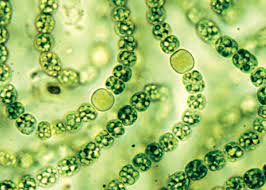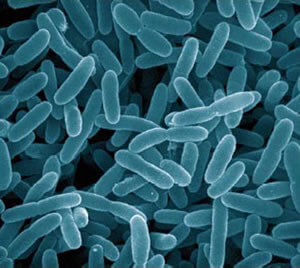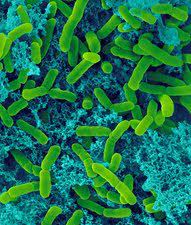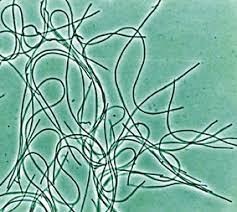Photosynthetic bacteriaThe photosynthetic bacteria that carry out photosynthesis process in absence of oxygen are called as anoxygenic. They consist of four distinct phyla including purple sulfur bacteria, purple non sulfur bacteria, green sulfur bacteria, and green non sulfur bacteria. The purple sulfur bacteria and purple non sulfur bacteria are the main photosynthetic bacteria that contain the pigment for the production of phytohydrogen that is required to carry out the photosynthesis process. These bacteria can produce hydrogen in response to light exposure and oxygen depleted conditions. the produced hydrogen bye photosynthetic bacteria is catalyzed by the enzyme nitrogenase and from several studies, it is true that these bacteria can use Various molecules such as organic acid, amino acid, sugar, sulphide and waste material as substrate for their culture. It is considered that the mechanism of photosynthetic bacteria producing the hydrogen molecule is done by the capture of photons and then the energy is transferred to the reaction center for further charge separation. What are Photosynthetic Bacteria?Generally, photosynthetic bacteria are the bacteria that have the ability to convert light energy from the solar into chemical energy through a process called as Photosynthesis. Photosynthetic bacteria are also classified as Photoautotrophs as they can prepare their own energy utilizing the inorganic compounds from the surrounding. That's why, they are self-dependent and are not fully depended on others to produce energy. There are several types of photosynthetic bacteria widely spread in both terrestrial and aquatic environment. They can be present in soil, oceans, lakes, sludge etc. In marine habitat, most photosynthetic bacteria are found abundantly. They also act as primary producer in the food chain. Photosynthetic bacteria also play pivotal role in oxygen production and carbon fixation processes. They are majorly divided into five groups -
Now, let's learn each photosynthetic bacteria in details starting with 1. Cyanobacteria
It is also known as Blue-green algae. They are members of Gram negative bacteria commonly present in aquatic ecosystem. However, over 2000 species are present and identified in the phylum Cyanobacteria. It is reported that more than 6000 species are spread across different habitats throughout the globe. Due to the ability of some species in the cyanobacteria phylum to fix nitrogen, hence they found be in a symbiotic relationship with various plants and lichens. Moreover, many other species are also found to be existing freely in soil and water. Photosynthesis in Cyanobacteria Photosynthesis in Cyanobacteria is functioned by the release of oxygen, same as photosynthesis process in plants and animals. This kind of photosynthesis process is considered as oxygenic phototrophic bacteria. However, they are characterized by the exhibition of variation and flexibility in their pigmentation. While the majority of Cyanobacteria species consist of chlorophyll a and allophycocyanine and also some carotenoids. And other species of Cyanobacteria like Prochlorococcus and Acaryochloris contains chlorophyll b and chlorophyll d respectively while other species contain phycoerythrin. In some studies, it is shown that chlorophyll a gets transferred into chlorophyll b leading to some changes due to environmental conditions. Like the photosynthesis mechanism in other oxygenic phototrophs, the mechanism of photosynthesis in cyanobacteria which involves the linear transfer of electrons. Here, the transfer of electron from water to NADP which is (Nicotinamide Adenine Dinucleotide Phosphate) via photosystem 1 and photosystem 2 resulting in the oxygen and ATP production. Generally, the cyanobacteria photosynthesis process involves the steps: First, the light energy is absorbed by the photosystem 2 located on the surface of thylakoid membrane of chloroplast in cyanobacteria. This step splits the water molecule releasing oxygen and electrons. The released electrons from the first step are then transferred by PQ (Plastoquinone is an isoprenoid quinone molecule that works in electron transport chain) into the thylakoid membrane to the cytochrome b6f complex. Then the electrons from b6 complex are transferred to the photosystem 1 (PSI) by plastocyanin (PC) through the lumen of thylakoid. In photosystem 1, the electrons are excited by light energy for the second time before reducing NADP+. Next, the protons generated during the process enters the thylakoid lumen where they promote the synthesis of ATP by the enzyme ATP synthase. While the electrons produced from photosystem 1 reenters the plastoquinone pool which has a role in the production of more energy in the form of ATP rather than NADPH. 2. Proteobacteria
It is also known as Purple Bacteria which belongs to a group of photosynthetic bacteria of phylum Proteobacteria. Proteobacteria, like Cyanobacteria are Gram negative bacteria widely found in all parts of the globe. However, the phylum Proteobacteria has many pathogenic bacterial genera such as Salmonella, E.coli, and Vibrio. According to the investigation, it is reported that more than 460 genera are present within the phylum Proteobacteria with over 1600 species. They contain five major classes including Alpha- Proteobacteria, Beta- Proteobacteria, Gamma-proteobacteria, Epsilon-proteobacteria and Delta-proteobacteria. Photosynthesis in Proteobacteria As cyanobacteria are aerobic photosynthetic bacteria while the members of phylum Proteobacteria are mostly occurred to be anoxygenic photosynthetic. Although, some species are identifies as aerobic in different habitats across the globe. Unlike plants and some other photosynthetic bacteria such as Cyanobacteria, the Proteobacteria have the ability to photosynthesis by containing only a single photosystem which is bacteriochlorophyll present within the intracellular membrane. Due to the simpler mechanism of photosynthesis present in Proteobacteria, they are unable to split the water molecule to release oxygen molecules. Simple organic acids or hydrogen disulfide H2S are frequently used as electron donor in anaerobic conditions. The electrons obtained from these sources are later transported through various electron carriers before protons H+ are pumped through the channels of membrane to produce a protein gradient. This proton gradient is then utilized by ATP synthase enzyme to produce ATP as energy currency. While the purple sulfur bacteria utilize sulfur and hydrogen as an electron donor elements whereas the non-sulfur bacteria usually utilize organic carbon compounds as an energy source. Rhodobacter sphaeroides Rhodobacter capsulatus Chromatium okenii Rhodopseudomonas palustris Alorhodospira halophile 3. Heliobacteria
Heliobacteria are the bacteria that first got introduced in 1983. Similar to cyanobacteria, most known members of this group have the ability to fix nitrogen. Many bacteria species of Heliobacteria can be found in rice paddy fields while some species can also be present in other kinds of soil like marshy or in aquatic environment. Heliobacteria are generally obligate anaerobic bacteria and known to be sensitive to oxygen. In addition, they also have the ability to do photosynthesis without releasing oxygen. Although they can only do simple photosynthesis process. Heliobacteria are considered to be incapable of autotrophic growth as such these heliobacteria are crucial for nitrogen fixation. When compared to the other bacteria which are capable of photosynthesis heliobacteria has shown to contain unique photosynthetic pigment called as bacteriochlorophyll g. The photosynthetic growth is altered by oxygen molecule in heliobacteria. They also contain a characteristic reaction center Where iron sulfur act as end electron acceptor. This class of reaction center is classified under Type 1 reaction center which is distinct from those bacteria found in purple bacterial species. Generally, the electrons are first transfer from cytochrome c (a structure bound to membrane) to a chlorophyll like molecule through photosystem 800 before reaching the iron sulfur Fe-S center. Some stages in process of electron transfer such as transfer of electron from cytochrome to P800 (photosystem 800) have been shown to be dependable on environmental conditions such as temperature and viscosity of the reaction medium and many more. Heliobacterium mobilis and Heliobacterium modesticaldum are considered to the common photosynthetic heliobacteria. 4. Chlorobi
It is also referred as the Green Sulfur bacteria. Most obligatory anaerobic bacteria comes under the phylum Chlorobi. The anaerobic bacteria are those that grows only in oxygen depleted conditions. As it says, the species of this phyla are commonly found in high sulfur rich habitats featured by low light intensities. In marine environment, Cholori can be present in the bottom of the photic zone in the ocean. The photic zone is the zone that is near the surface of ocean. And they also have the ability to capture light energy which is required for photosynthesis. The presence of green sulfur bacteria in the lowermost part of the photic zone allows them to capture light energy and also to protect themselves from the atmospheric oxygen as they are obligatory anaerobic bacteria. This class of bacteria is highly sensitive to oxygen. Alike some of the other photosynthetic bacteria, the green sulfur bacteria are obligate phototrophs which so the photosynthesis and thus do not depend on any other source of energy from the surrounding. As they are sulfur bacteria which commonly found in high sulfur habitats with low exposure of light. These green sulfur bacteria consist of large molecule of light harvesting complex known as Chlorosome. The green sulfur bacteria are known to contain of bacterio-chlorophylls BChl c, BChl d, and BChl e. these light harvesting complexes are huge in size to contain approximately 200,000 bacterio-chlorophyll molecules. For this type of bacteria, it is very crucial to capture at least the required energy light photons required for photosynthesis. Photosynthesis in Green Sulfur Bacteria As above said that the green sulfur bacteria are anoxygenic phototrophs that does not require oxygen to carry out the process of photosynthesis. For this reason, these bacteria use sulfur (or other derivative of sulfur or sulfur like material thiosulfate) in place of water as an electron donor. It splits the water which releases oxygen molecule. These electrons are later utilized for carbon fixing through the non-cyclic electron transport chain ETC which associated with the NADPH production. In the non-cyclic system, electrons transported through the electron transport chain which results in NADPH by reducing the NADP molecule, which ultimately used for the fixation of carbon. 5. Chloroflexi
They are also referred as Cholorobacteria, the phylum Chloroflexi consist of bacteria with different characteristics. For that, some species exist as aerobic thermophile that require oxygen supply to live chemo-heterotroph lifestyle, while other species exist as anoxygenic photoautotrophs that utilizes light energy to carry out photosynthesis process. The phylum Chloroflexi have members that are ecologically and physiologically diverse in nature and can be present in different habitats such as hot springs and sediments and many more. Most classes within the phylum Chloroflexi are featured by a presence of filamentous morphology. The phylum Chloroflexi has only one class which is Chloroflexia, also referred as filamentous green non sulfur bacteria that are phototrophic in nature. The Chlorosomes are the light harvesting complexes that are associated with choloroflexi bacterial species. This light producing complex known as Chlorosomes contains bacterio-cholorophyll c in it. Cholorosomes are structure that are located to the inner side of cell membrane which contains light harvesting bacterio-chlorophyll d and some bacterio-chlorophyll a. Some species like Chloroflexus aurantiacus have been shown to consist of complex III which is menaquinol in the place of cytochrome bc that is present in all other species. This complex III is involved in electron transport during photosynthesis. Hence, the photosynthesis process is not well studied in this class Chloroflexi, and most photosynthetic bacteria of this class belong to Chloroflexia. Use of photosynthetic bacteria as sustainable microbial production hostIt is important to manage environment for sustainable growth and development. Microorganisms can also use to clean search contaminated environment which provides an alternative method to reduce the conventional treatment and their cost. Here the photosynthetic bacteria comes as a savior to reduce pollutants and generating valuable products by cleaning the contaminated environment. Photosynthetic bacteria are reported to be capable of degrading the pollutants. As we know the synthesis of high content compound in organisms especially photosynthetic can be a potential method to reduce effective cost and can contribute 2a sustainable system as they can use sunlight and CO2 present in the atmosphere for their growth. Experimental research has shown that purple non sulfur bacteria exhibit a nitrogen fixation ability which means they can utilize atmospheric nitrogen and use it for their growth. They are also isolated from aquatic environment as there are abundantly present in the natural sea water. For that they have concluded, the aquatic purple photosynthetic bacteria could be an ideal host for the production of microbes. They also shown to produce hydrogen gas, polyhydroxyalkanoate, and nucleic acids.
Next TopicBlood Group
|
 For Videos Join Our Youtube Channel: Join Now
For Videos Join Our Youtube Channel: Join Now
Feedback
- Send your Feedback to [email protected]
Help Others, Please Share










